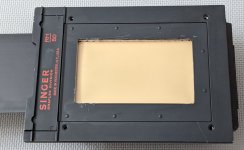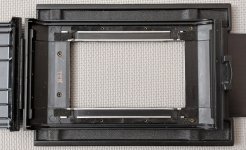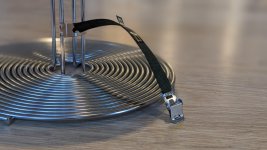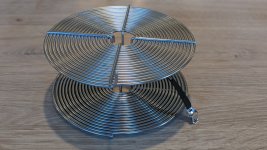Nokton48
Mentor
I have another question: when you load the bulk film into cassette in the dark, how do you measure the length of the film? For example: 24 exposures (about 64" including leaders I guess, like 220). Do you have any DIY device to keep track of the length of film loaded?
Yes sixty-four inches will just fit onto a modified Paterson reel. I took a wooden yardstick, and cut it down to thirty-two inches. Then I used blue painters masking tape, to attach the yardstick to the front edge of the formica table which I use for film loading in my darkroom. I roll out thirty-two inches, and roll it up on the plastic 70mm spool. Then I unroll another thirty-two inches of film stock, and finish by winding it onto the spool. When you attach the film to the spool DON"T use tape, use the silver spring clip that should come with the 70mm cassette. You can damage your film back if you don't allow the film to detach itself and wind into the receiver cassette at the end of the roll.
In their instructions for the A70 Hasselblad recommends using a loading table, and a wooden rule to properly measure out the film stock. I've been doing that and it works well. I've also used Brett's method and that works well too
Nokton48
Mentor
z.bruce.li
Established
Thank you both Nokton48 and Sarcophilus Harrisii for the clear instruction! I will start with Brett's method to test the water first.
The film from India is arriving surprisingly fast: actually 9 days instead of the ebay estimate of over 1.5 months (presumably by a boat). So I will get a chance to load some cassettes this weekend.
The film from India is arriving surprisingly fast: actually 9 days instead of the ebay estimate of over 1.5 months (presumably by a boat). So I will get a chance to load some cassettes this weekend.
Nokton48
Mentor
I have one of those olde Paterson original model tanks coming from England. Since it takes 616 film it should handle that length of 70mm at least. Anybody know how long a strip of 616 is? Wait I can measure it with a dummy roll. 



 No doubt less than a length of 220 which is about 68 inches or so. But good for short lengths, like when doing clip tests to nail development times in certain soups
No doubt less than a length of 220 which is about 68 inches or so. But good for short lengths, like when doing clip tests to nail development times in certain soups
z.bruce.li
Established
I got two Ansco daylight tanks that handles 616 width, and 220 length. Thus shoot 24 frames then cut and develop, seem to be a good way to go for me.
Nokton48
Mentor
 70mm PL100 MicX Makiflex 2 by Nokton48, on Flickr
70mm PL100 MicX Makiflex 2 by Nokton48, on FlickrTesting 70mm Beatty Coleman Transet Back on Plaubel Makiflex. Auto Iris 210mm Makiflex Xenar Unperforated 70mm Efke PL100 Legacy Mic-X Arista 8x10 RC [NODE="2"]Forum[/NODE] Multigrade dev
Nokton48
Mentor
I got two Ansco daylight tanks that handles 616 width, and 220 length. Thus shoot 24 frames then cut and develop, seem to be a good way to go for me.
Thanks. Taking 220 length will be very useful for certain shoots. For me that can be Hasselblad or Graflex RH-50. 6x6 and 6x7. Good to have both.
I took my Hasselblad and a Magazine 70 loaded with Kodak Plus-X 70mm with me on a visit to historic Port Arthur, a UNESCO World Heritage site and former penal settlement last month. Frustratingly, my mag still has a light leak which affected some frames despite the precaution of completely taping the whole joint between camera body and mag. Despite this, I got a few usable images, some of which I have edited, and three such appear below.
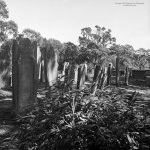
Tombstones, Isle Of The Dead
Tuesday 20th September 2022.
Camera: Hasselblad 500C/M SLR.
Lens: Carl Zeiss 80mm Planar f/2.8.
Film: Kodak Plus-X 70mm ISO 125 black & white negative @ EI 80 in Hasselblad Magazine 70.
Exposure: 1/60 @ f/8.
Development: ID-11 1 + 3 20C/16m.
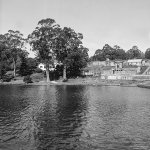
Port Arthur Guard Tower & Commandant's Cottage
Tuesday 20th September 2022.
Camera: Hasselblad 500C/M SLR.
Lens: Carl Zeiss 250mm Sonnar f/5.6.
Film: Kodak Plus-X ISO 125 70mm black & white negative @ EI 80.
Exposure: 1/250 @ f/8.
Development: ID-11 1 + 3 20C/16m.
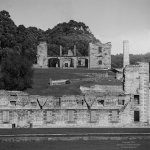
Port Arthur Hospital & Penitentiary
Tuesday 20th September 2022.
Camera: Hasselblad 500C/M SLR.
Lens: Carl Zeiss 250mm Sonnar f/5.6.
Film: Kodak Plus-X ISO 125 70 millimetre black & white negative @ EI 80.
Exposure: 1/250 @ f/8.
Development: ID-11 1 + 3 20C/16m.

Tombstones, Isle Of The Dead
Tuesday 20th September 2022.
Camera: Hasselblad 500C/M SLR.
Lens: Carl Zeiss 80mm Planar f/2.8.
Film: Kodak Plus-X 70mm ISO 125 black & white negative @ EI 80 in Hasselblad Magazine 70.
Exposure: 1/60 @ f/8.
Development: ID-11 1 + 3 20C/16m.

Port Arthur Guard Tower & Commandant's Cottage
Tuesday 20th September 2022.
Camera: Hasselblad 500C/M SLR.
Lens: Carl Zeiss 250mm Sonnar f/5.6.
Film: Kodak Plus-X ISO 125 70mm black & white negative @ EI 80.
Exposure: 1/250 @ f/8.
Development: ID-11 1 + 3 20C/16m.

Port Arthur Hospital & Penitentiary
Tuesday 20th September 2022.
Camera: Hasselblad 500C/M SLR.
Lens: Carl Zeiss 250mm Sonnar f/5.6.
Film: Kodak Plus-X ISO 125 70 millimetre black & white negative @ EI 80.
Exposure: 1/250 @ f/8.
Development: ID-11 1 + 3 20C/16m.
Nokton48
Mentor
Hi Brett!
Looks like that original Plus-X is still in good condition I am relieved
I am relieved  I like this film in Legacy Microdol-X from Freestyle. I mix a gallon, last one was fine even after three and a half years. The mixture gets better after being replenished and "seasons" for a while. Works good in the Kindermann 70mm Tanks, they hold nearly a gallon. Classic deep tank developer that gets better with age. I think that film was from 1982 or so, last of the last of the original 70mm Plus-X. And of course D76 types are the go-to for original Plus-X. It is lovely stuff! EI 80 is about right, I like "beefy" negatives for printing on silver graded paper.
I like this film in Legacy Microdol-X from Freestyle. I mix a gallon, last one was fine even after three and a half years. The mixture gets better after being replenished and "seasons" for a while. Works good in the Kindermann 70mm Tanks, they hold nearly a gallon. Classic deep tank developer that gets better with age. I think that film was from 1982 or so, last of the last of the original 70mm Plus-X. And of course D76 types are the go-to for original Plus-X. It is lovely stuff! EI 80 is about right, I like "beefy" negatives for printing on silver graded paper.
Looks like that original Plus-X is still in good condition
Nokton48
Mentor
 70mm PL100 MicX Makiflex 1 by Nokton48, on Flickr
70mm PL100 MicX Makiflex 1 by Nokton48, on FlickrTesting 70mm Beatty Coleman Transet Back on Plaubel Makiflex. Auto Iris 210mm Makiflex Xenar Unperforated 70mm Efke PL100 Legacy Mic-X Arista 8x10 RC [NODE="2"]Forum[/NODE] Multigrade dev
zhorton
Member
Hi all, I've been lurking in this thread for a long time, and it has been partially responsible for rekindling my excitement about 70mm! One thing that has always bugged me about the format: the backs available, even for large format cameras, max out at the 6x7 frame size. I've always thought this was ridiculous: you have this huge roll of film, a big camera, and you're only going to expose that (relatively) tiny frame? I've read various references to the possibility of machining the Graflex RH50 back to larger format sizes, and finally decided to take the plunge and give it a try. Here are my results:
The RH50 can be machined to accept up to a 6x10 format aperture (57 x 98mm). Any larger than that would eliminate the darkslide. Unfortunately, the back is constructed of both a milled aluminum segment and a hardened steel segment (the plate on the camera side). The former can be milled fairly easily, but the latter is extremely resistant to milling. It quickly destroys end mills ("blades") and cuts jagged. It requires a ton of hand filing to get into shape. So this modification is possible but difficult and a little ugly (though that doesn't affect the function).
The good news is that the film transport mechanism works perfectly for the new format. In order to wind the large, 6x10 format, one simply advances 1.5 frames instead of one. The way the back is geared, this is easy to do and works out well. I shot a test roll of film and spacing was excellent.
The RH50 can be machined to accept up to a 6x10 format aperture (57 x 98mm). Any larger than that would eliminate the darkslide. Unfortunately, the back is constructed of both a milled aluminum segment and a hardened steel segment (the plate on the camera side). The former can be milled fairly easily, but the latter is extremely resistant to milling. It quickly destroys end mills ("blades") and cuts jagged. It requires a ton of hand filing to get into shape. So this modification is possible but difficult and a little ugly (though that doesn't affect the function).
The good news is that the film transport mechanism works perfectly for the new format. In order to wind the large, 6x10 format, one simply advances 1.5 frames instead of one. The way the back is geared, this is easy to do and works out well. I shot a test roll of film and spacing was excellent.
Attachments
zhorton
Member
Well done. Keen to see some images through that at some stage.Hi all, I've been lurking in this thread for a long time, and it has been partially responsible for rekindling my excitement about 70mm! One thing that has always bugged me about the format: the backs available, even for large format cameras, max out at the 6x7 frame size. I've always thought this was ridiculous: you have this huge roll of film, a big camera, and you're only going to expose that (relatively) tiny frame? I've read various references to the possibility of machining the Graflex RH50 back to larger format sizes, and finally decided to take the plunge and give it a try. Here are my results:
The RH50 can be machined to accept up to a 6x10 format aperture (57 x 98mm). Any larger than that would eliminate the darkslide. Unfortunately, the back is constructed of both a milled aluminum segment and a hardened steel segment (the plate on the camera side). The former can be milled fairly easily, but the latter is extremely resistant to milling. It quickly destroys end mills ("blades") and cuts jagged. It requires a ton of hand filing to get into shape. So this modification is possible but difficult and a little ugly (though that doesn't affect the function).
The good news is that the film transport mechanism works perfectly for the new format. In order to wind the large, 6x10 format, one simply advances 1.5 frames instead of one. The way the back is geared, this is easy to do and works out well. I shot a test roll of film and spacing was excellent.
Did anyone ever have more fun with 70 millimetre film than the 24 men who went to the Moon on nine Apollo flights? Arguably, not. Just out is a book "Apollo Remastered" which contains many images from files created directly from scans of the original films shot in space. Previous images published were based on duplicates or copies of these. The originals were removed from their storage freezer, thawed and scanned by NASA using a Leica DSW700 scanner (I was not previously aware Leitz made scanners, but they do, very, very good ones, apparently). I've ordered a copy of the book for Christmas and can't wait to see it. FYI.
zhorton
Member
Well done. Keen to see some images through that at some stage.
Here you go! I finally scanned in my test roll. Here are two uncropped images to show the format. I call it "6x10" but in comparison to nominal 6x9 it is wider than that would suggest!
 6x10 Hydrant with Car by Zach Horton, on Flickr
6x10 Hydrant with Car by Zach Horton, on Flickr 6x10 Porches by Zach Horton, on Flickr
6x10 Porches by Zach Horton, on Flickrz.bruce.li
Established
M.O.I
Newbie
I miss a Cine Rollex + cartridges for 90€...
Was a good deal?
Was a good deal?
I miss a Cine Rollex + cartridges for 90€...
Was a good deal?
Not too bad given recent asking prices, I have been watching them myself and most BIN prices are rather more. Loose cassettes are hard to find for $10 or $20, so with two included it was reasonable I think. Having a Super Technika I would not mind a Cine Rollex myself, but one must pay careful attention to the bottom plate, as many advertised were for the baby Linhofs with circular mounting flange as opposed to more versatile Graflok fit.
Nokton48
Mentor
Hi all, I've been lurking in this thread for a long time, and it has been partially responsible for rekindling my excitement about 70mm! One thing that has always bugged me about the format: the backs available, even for large format cameras, max out at the 6x7 frame size. I've always thought this was ridiculous: you have this huge roll of film, a big camera, and you're only going to expose that (relatively) tiny frame? I've read various references to the possibility of machining the Graflex RH50 back to larger format sizes, and finally decided to take the plunge and give it a try. Here are my results:
The RH50 can be machined to accept up to a 6x10 format aperture (57 x 98mm). Any larger than that would eliminate the darkslide. Unfortunately, the back is constructed of both a milled aluminum segment and a hardened steel segment (the plate on the camera side). The former can be milled fairly easily, but the latter is extremely resistant to milling. It quickly destroys end mills ("blades") and cuts jagged. It requires a ton of hand filing to get into shape. So this modification is possible but difficult and a little ugly (though that doesn't affect the function).
The good news is that the film transport mechanism works perfectly for the new format. In order to wind the large, 6x10 format, one simply advances 1.5 frames instead of one. The way the back is geared, this is easy to do and works out well. I shot a test roll of film and spacing was excellent.
That is beautiful work. I may need to hack my three RH50's to 6x9cm soon, I will be happy as a clam when I accomplish that. So the film counter is disabled right? I can live without that myself
z.bruce.li
Established
Hi, I recently got a Kindermann 70mm SS reel but got puzzled with a belt and clip thing (almost permanently attached(. What are they for? I practiced loading film onto it and was successful without the belt and clip. Do you happen to have experience with this type of SS reel? Thank you!
Attachments
Share:
-
This site uses cookies to help personalise content, tailor your experience and to keep you logged in if you register.
By continuing to use this site, you are consenting to our use of cookies.



